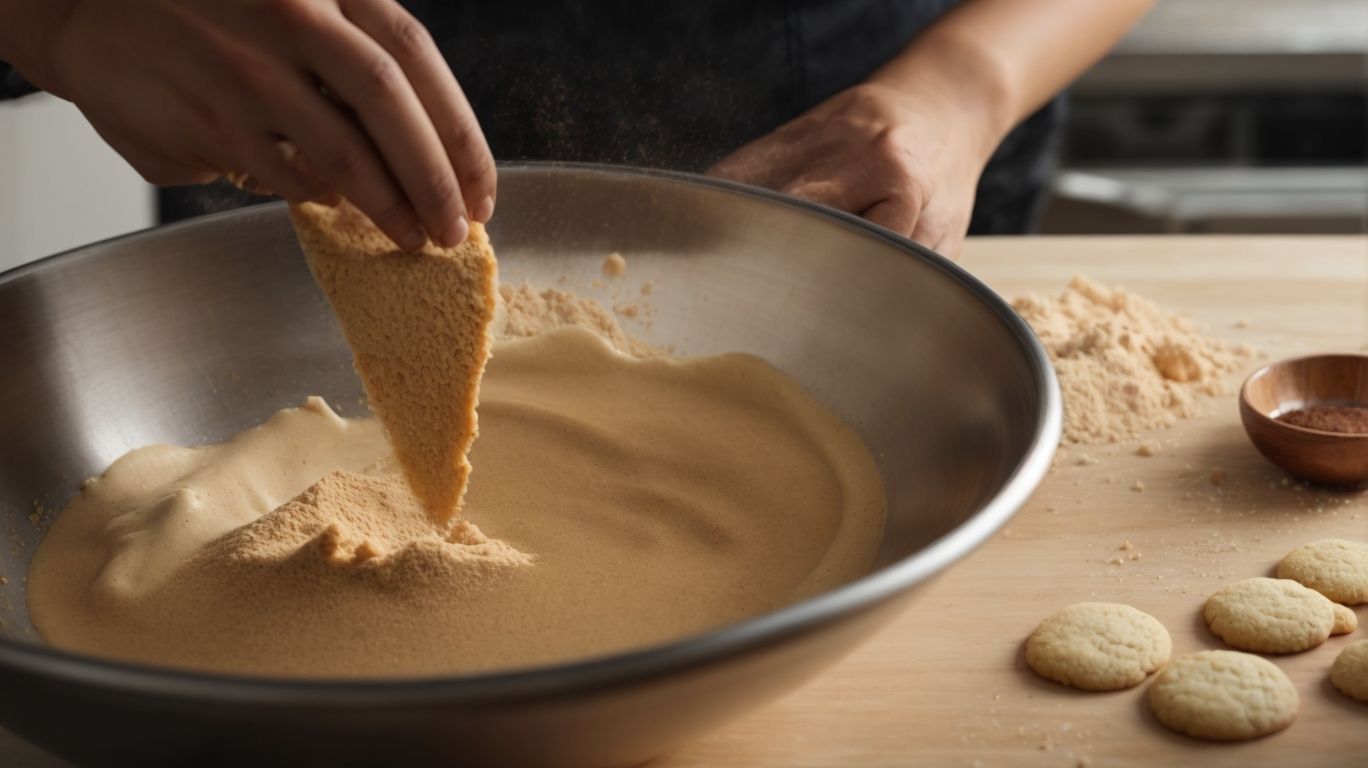How to Bake Cookies Without Eggs?
Are you looking to bake delicious cookies without using eggs? Whether it’s due to allergies, dietary restrictions, or following a vegan lifestyle, there are plenty of reasons to explore eggless baking.
In this article, we’ll discuss why you might choose to bake without eggs, what substitutes you can use, how to incorporate them into your recipes, and essential tips for successful eggless baking. Plus, we’ll share some mouth-watering recipes for eggless cookies that you’ll love. Let’s get started!
Key Takeaways:
Why Bake Without Eggs?

Credits: Poormet.Com – Ronald Nelson
Baking without eggs is a common choice due to various reasons such as allergies, dietary restrictions, and preferences.
For those with allergies to eggs, finding alternatives becomes essential to enjoy baked goods without compromising on health. Individuals with dietary restrictions such as vegans or vegetarians often turn to egg-free baking to adhere to their beliefs. Health-conscious individuals may also opt for eggless recipes to reduce cholesterol intake or experiment with lighter, lower-calorie alternatives. Some people simply prefer the taste and texture of egg-free baked goods, leading them to explore delicious, creative ways to bake without eggs. By accommodating these diverse needs and preferences, egg-free baking has become increasingly popular in today’s culinary landscape.
Allergies and Dietary Restrictions
Regarding baking, allergies and dietary restrictions play a significant role in the decision to omit eggs from recipes.
For individuals with allergies to eggs, using substitutes becomes crucial to still enjoy delicious baked goods. Common allergens in baking include eggs, nuts, milk, and gluten.
Fortunately, there are plenty of alternative ingredients that can replace eggs in recipes without compromising on taste or texture. Ingredients like applesauce, mashed bananas, silken tofu, or commercial egg replacers can work wonders in various baked treats.
When accommodating different dietary needs, effective communication is key. Always ask guests about their allergies or dietary restrictions before serving them baked goods to ensure everyone can enjoy the treats safely.
Vegan and Plant-based Diets
For individuals following vegan or plant-based diets, baking without eggs is a way to align with their dietary preferences and ethical beliefs.
By skipping eggs in their baking recipes, these individuals contribute to reducing the demand for factory-farmed eggs, supporting animal welfare causes. A variety of plant-based substitutes like flaxseeds, applesauce, or silken tofu can mimic the binding and leavening properties of eggs, ensuring that their baked goods turn out just as delicious and moist. Not only does eliminating eggs result in a lighter eco-footprint due to reduced greenhouse gas emissions associated with egg production, but it also promotes a healthier lifestyle by lowering cholesterol intake and increasing fiber consumption.
What Can Be Used As An Egg Substitute?

Credits: Poormet.Com – Andrew Anderson
There are several effective and versatile substitutes that can be used in place of eggs when baking to achieve similar results.
One popular egg substitute is applesauce, which adds moisture and a subtle sweetness to baked goods. It works well in quick breads, muffins, and cakes.
- Another common option is mashed bananas, which not only bind ingredients together but also add flavor and moisture. This is great for banana bread and other sweet treats.
- Flaxseed meal mixed with water forms a gel-like consistency similar to eggs, making it ideal for binding in recipes like pancakes and cookies.
Flaxseed or Chia Seed Gel
A popular egg substitute in baking is the flaxseed or chia seed gel, known for its binding properties and nutritional benefits.
Preparing flaxseed or chia seed gel as an egg replacement is simple and effective. To make flaxseed gel, mix 1 tablespoon of flaxseed meal with 3 tablespoons of water and let it sit for a few minutes until it thickens. Chia seed gel can be made by combining 1 tablespoon of chia seeds with 2-3 tablespoons of water and allowing it to gel. The resulting gel can be used in place of eggs in various recipes.
Applesauce or Mashed Banana
Applesauce and mashed banana are popular fruit-based substitutes for eggs in baking, imparting moisture, sweetness, and natural binding properties to the recipes.
When used as an egg alternative, applesauce lends a subtle fruity flavor that complements cinnamon-spiced treats like muffins and quick breads. Its natural sweetness reduces the need for extra sugar, making it a healthier option for those with a sweet tooth. On the other hand, mashed banana brings a distinct tropical note to baked goods, enhancing the taste of items like banana bread and pancakes. The texture of these substitutes varies; applesauce adds a moist and tender crumb, while mashed banana contributes a denser, more substantial consistency.
Silken Tofu
Silken tofu serves as a versatile and protein-rich egg substitute in baking, offering a creamy texture and excellent binding capabilities.
One of the standout features of using silken tofu as an egg replacement is its impressive nutritional profile. Packed with plant-based protein, essential amino acids, and micronutrients, such as iron and calcium, it adds a healthy twist to your baked goods. The smooth and silky consistency of silken tofu blends seamlessly into batters and doughs, resulting in moist and tender baked treats. Whether you’re making cakes, brownies, muffins, or even custards, this vegan-friendly option can effortlessly recreate the richness usually provided by eggs.
Baking Powder and Oil
A combination of baking powder and oil can act as a quick and convenient egg substitute, providing leavening and moisture to baked goods.
When using baking powder as an egg substitute, it’s crucial to understand its role in helping the baked goods rise. Baking powder contains acid and alkaline components that react when mixed with liquid, creating carbon dioxide bubbles. These bubbles are what give the baked goods their light and airy texture.
Oil, on the other hand, contributes moisture, which is essential in achieving a moist and tender crumb in the absence of eggs. This dynamic duo can be particularly effective in recipes like muffins, quick breads, and cakes.
How To Use These Substitutes In Baking?

Credits: Poormet.Com – David Nguyen
Implementing egg substitutes effectively in baking requires understanding their unique properties and adapting them to specific recipes.
When selecting an egg substitute, consider the purpose of the eggs in the original recipe. For binding, flaxseed meal mixed with water or aquafaba from canned chickpeas can work wonders. To add moisture and richness, opt for options like applesauce, mashed bananas, or yogurt. For leavening, baking powder or baking soda mixed with vinegar can do the trick.
It’s crucial to pay attention to quantities when substituting eggs to maintain the right consistency and structure. A general rule of thumb is to use around 1/4 cup of egg substitute for every egg in the recipe, but this can vary depending on the specific substitute and the desired outcome.
Flaxseed or Chia Seed Gel
To use flaxseed or chia seed gel as an egg alternative, prepare a thick mixture by combining the seeds with water and allowing it to gel before adding it to the recipe.
When making the gel, the ratio is typically 1 tablespoon of seeds to 3 tablespoons of water, but this may vary based on the recipe’s requirements. It’s essential to let the mixture sit for about 10-15 minutes until it reaches a gooey, gel-like consistency. This gel binds ingredients together and adds moisture, making it an excellent vegan-friendly substitution. Remember to adjust the liquids and fats in your recipe slightly to accommodate the extra moisture from the gel.
Applesauce or Mashed Banana
When using applesauce or mashed banana instead of eggs, ensure to adjust the sugar content in the recipe to account for the additional sweetness from these fruit-based substitutes.
Since applesauce and mashed banana possess natural sweetness, reducing the sugar amount is crucial to prevent the dish from becoming overly saccharine. Balance is key here; you don’t want the dessert to be excessively sweet. Texture is another aspect to consider – eggs contribute to the structure and binding of baked goods, so expect a slightly different consistency when using fruit purees as replacements.
Silken Tofu
Incorporating silken tofu as an egg replacement may require blending it into a smooth consistency to avoid any tofu chunks in the final baked product.
To start, ensure you have the right amount of silken tofu needed to substitute for eggs in your recipe. Generally, 1/4 cup of blended silken tofu equals one egg. When blending, aim for a creamy and lump-free texture. Adding a bit of liquid, like water or plant-based milk, can help achieve the desired consistency.
Because silken tofu is relatively neutral in flavor, it won’t affect the taste of your baked goods. This makes it ideal for recipes where you want the flavors to shine through without any tofu taste.
When using silken tofu as an egg substitute for binding purposes, remember that it has great binding capabilities. Its smooth texture helps create a cohesive structure in baked goods. Mix the blended tofu into your batter or dough thoroughly to ensure proper binding.
Baking Powder and Oil
When substituting eggs with baking powder and oil, ensure to adjust the overall liquid and leavening agents in the recipe to maintain the desired texture and structure.
It’s crucial to understand that eggs play a key role in binding, leavening, and providing moisture in baking recipes. By using a combination of baking powder and oil as a substitute, you need to compensate for the differences in these functions.
When incorporating this substitute, consider increasing the amount of liquid in the recipe to make up for the moisture provided by eggs. Since baking powder acts as a leavening agent, you may have to tweak the quantity to achieve the right rise and texture. Mind these adjustments to ensure your final baked goods turn out just as delightful!
Tips for Successful Eggless Baking
Achieving excellent results in eggless baking requires attention to detail, proper ingredient selection, and understanding the functions of various substitutes.
Regarding ingredient adjustments, flaxseed meal mixed with water makes a great egg replacement due to its binding properties. Another option is silken tofu, which works well in dense baked goods like brownies. Experimenting with applesauce, mashed bananas, or even avocado can also provide moisture and binding in recipes.
Mixing techniques are vital; ensure proper incorporation of dry and wet ingredients without overmixing to maintain the desired texture. Baking time optimization varies; start checking for doneness a few minutes before the suggested time to prevent overbaking. Common issues like dense textures can be avoided by using leavening agents like baking powder or soda and adjusting oven temperature for an even bake.
Adjusting Ratios and Ingredients
When adapting recipes for eggless baking, it is crucial to carefully adjust ingredient ratios and selections to ensure the desired texture, flavor, and structure.
One of the key factors to consider is finding the right balance between wet and dry ingredients, as eggs provide moisture and binding properties in traditional baking. Substituting this crucial element requires precision to prevent the final product from being too dense or dry.
Additionally, consistency plays a vital role in achieving the desired outcome. Choosing appropriate replacements for eggs, such as applesauce, yogurt, or flaxseed, can contribute to maintaining the right texture and consistency in your baked goods.
Mixing and Incorporating Ingredients
Proper mixing and incorporation of ingredients in eggless baking are crucial for achieving uniform textures, flavors, and baking outcomes.
When starting the process, it’s essential to ensure that all your ingredients are at room temperature. This helps them blend together seamlessly and creates a smoother batter. Begin by sifting your dry ingredients together to prevent clumps and ensure even distribution. As you add each liquid component, such as oil or milk, do so gradually while gently folding them in. Overmixing can lead to tough baked goods, so remember to mix until just combined to maintain the desired lightness of the final product.
Baking Time and Temperature
Adapting baking time and temperature settings based on the eggless nature of the recipe is essential to prevent under or over-baking and ensure optimal results.
When working with eggless recipes, it’s crucial to remember that eggs play a significant role in structure and moisture. Without them, you might need to adjust the baking process to compensate for these missing elements. Texture can be a common concern, as eggs provide tenderness and help bind ingredients together. Therefore, monitoring the doneness of your baked goods becomes even more critical.
Experimenting with slightly lower temperatures for a longer time can often yield better results in eggless baking, allowing the product to cook through evenly without drying out. Covering the item with foil partway through baking can help retain moisture and prevent excessive browning on the surface.
Recipes for Eggless Cookies

Credits: Poormet.Com – Ralph Perez
Enjoy a delightful array of eggless cookie recipes that cater to various tastes and preferences, offering delectable treats for every occasion.
From the timeless chocolate chip cookies to exotic matcha green tea cookies, this collection has something for everyone. If you’re a fan of rich, chewy cookies, try the fudgy brownie cookies that are simply irresistible. For those who love a bit of crunch, the almond biscotti cookies will satisfy your cravings perfectly.
Feel free to experiment with flavors by adding vanilla extract, citrus zest, or crushed nuts to personalize your cookies. Whether you prefer soft and gooey or crispy and thin, these recipes provide detailed instructions to help you achieve the perfect texture every time.
Classic Chocolate Chip Cookies
Indulge in the timeless appeal of classic chocolate chip cookies made without eggs, featuring rich chocolate morsels in every bite.
If you’re looking for a delicious eggless version of this beloved treat, you’ve come to the right place. To start, gather unsalted butter, brown sugar, granulated sugar, vanilla extract, all-purpose flour, baking soda, and of course, chocolate chips. Begin by creaming the butter and sugars together until light and fluffy, then add in the vanilla extract. Next, sift the flour and baking soda into the mixture, and fold in the chocolate chips until evenly distributed in the dough.
Oatmeal Raisin Cookies
Savor the wholesome goodness of oatmeal raisin cookies sans eggs, combining chewy oatmeal, plump raisins, and warm spices for a delightful treat.
These eggless oatmeal raisin cookies are a perfect balance of sweetness and texture, ideal for those looking for a healthier treat. The key to their chewiness lies in the combination of rolled oats and raisins, which add a natural sweetness to every bite. And let’s not forget the warmth of cinnamon and nutmeg that enhance the flavors further.
To achieve the perfect cookie texture, make sure to refrigerate the dough before baking. This helps the cookies hold their shape and prevents them from spreading too much on the baking sheet.
Peanut Butter Cookies
Experience the irresistible allure of peanut butter cookies without eggs, showcasing the rich nutty flavor and buttery texture in every bite.
For this delectable treat, gather your ingredients starting with peanut butter (creamy or crunchy), sugar, all-purpose flour, baking soda, salt, milk, and vanilla extract.
In a mixing bowl, cream together the peanut butter and sugar until light and fluffy. Add in the flour mixture with baking soda and salt. Slowly incorporate milk and vanilla extract until the dough forms. Shape the dough into small balls and gently flatten them with a fork onto a baking sheet. Bake at 350°F for about 10-12 minutes until the edges are golden brown.
Indulge in these delicious eggless peanut butter cookies that are perfect for snack time or dessert.
Sugar Cookies
Enchant your taste buds with delightful sugar cookies that are free from eggs, featuring a tender crumb, buttery sweetness, and endless decorating possibilities.
These eggless sugar cookies are perfect for those with dietary restrictions or allergies, yet they don’t compromise on taste or texture. To create these delectable treats, you’ll need pantry staples like flour, sugar, butter, milk, and vanilla extract. For added flavor enhancements, consider mixing in cinnamon, nutmeg, or lemon zest. Once your dough is ready, roll it out and use cookie cutters to shape the cookies into fun designs. Before baking, sprinkle some colored sugar or sprinkles for a festive touch. Remember to chill the dough for best results and bake at the right temperature to achieve that perfect golden hue. Get creative with your decorating using royal icing or edible markers to add colorful designs. These eggless sugar cookies are sure to be a hit at your next gathering!
Frequently Asked Questions
1. How to Bake Cookies Without Eggs?
Baking cookies without eggs is a great alternative for those with allergies or dietary restrictions. You can use ingredients like applesauce, mashed bananas, or flaxseeds as replacements for eggs in your cookie recipes.
2. Can I use the same amount of egg substitute as eggs in my cookie recipe?
It is recommended to use the equivalent amount of egg substitute as eggs in your cookie recipe. However, be sure to check the instructions on the egg substitute packaging to determine the exact measurement needed.
3. Are there any other ingredients I can use to replace eggs in my cookies?
Yes, you can also use ingredients like yogurt, silken tofu, or aquafaba (the liquid from canned beans) as substitutes for eggs in your cookie recipes. These ingredients add moisture and help bind the dough together.
4. Will my cookies still turn out the same without eggs?
Cookies made without eggs may have a slightly different texture and may not rise as much as traditional cookies. However, they will still be delicious and have a similar taste as long as you use the right egg substitutes and follow the recipe correctly.
5. How do I know if my cookies are done baking without using eggs?
Cookies made without eggs may have a slightly shorter baking time, so it’s important to keep an eye on them. They are done when the edges are slightly golden and the center is set. You can also do a toothpick test to check for doneness.
6. Are there any other benefits to baking cookies without eggs?
Yes, besides catering to dietary restrictions, baking cookies without eggs can also make them lower in fat and cholesterol. It can also be a fun experiment to try different egg substitutes and see how they affect the taste and texture of your cookies.

